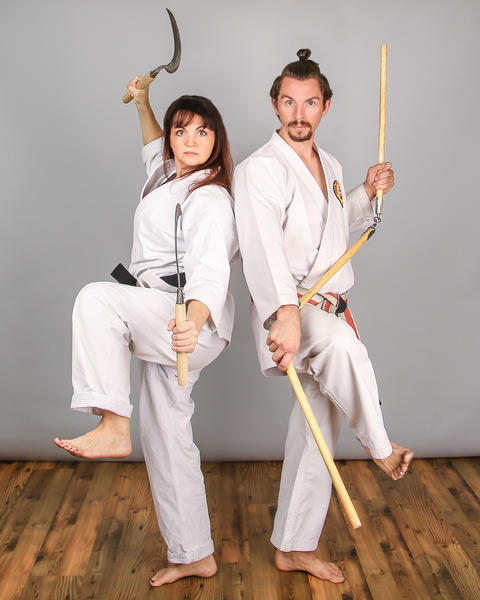It’s All the Same Only Different

By Guru Bruce Ogle
I have been telling my martial art friends and students that for somewhere around fifty-plus years, with mixed reactions, most of which are skeptical at best, to put it politely. However, you know what, I didn’t try to share with them, mainly because of their refusal to accept what I clearly and consistently showed them is that everything in life actually is all the same, only different.

Well, now that I have awakened your indignation, allow me to make some fairly clear observations of enlightenment for everyone to ponder, for at least a couple of seconds. After being exposed to, and comprehensively studying many diversified martial art styles from all around the world, it became abundantly obvious to me that they all have far more similarities than differences. Before your blood pressure becomes violently uncontrollable, let me simply point out an apparently not so obvious connection here.
First of all, we are all theoretically human beings, with the same physiological makeup. Which basically means, we are all the same, only different. Our anatomical skeletal structures, muscles, tendons, etc., gives us all fairly much very similar physical attributes with fairly similar capabilities, meaning the larger percentage of us are all the same physically, while being decidedly different.
Actually this really is a fairly DEEP subject, which could conceivably fill several volumes, so allow me to put some perimeters around this whole thing and just kind of stay within the spectrum of the martial art, but even at that, it’s still pretty deep and highly controversial. Be advised that I have developed my teaching methodologies and long martial art career with these concepts as the foundation and have assisted many MASTERS and several GRAND MASTERS utilizing them.
First of all let me say that the martial art is relatively new in main stream America and the extremely ridged structure that it has been suppressed by was in itself extremely limiting and self destructive.
In the very early days, student in America were not permitted to cross train or study with anyone other than their initial master, or else. Of course that was also extremely limiting to that MASTER’S overall knowledge, ability and exposure to the totality of his system or style. It took nearly one hundred years for that to slowly begin to change, so that other teachers and information sources were accepted and systems and styles began to evolve and further develop, broadening their spectrum. Over many years, I personally witnessed many highly recognized martial art professors, teaching the many diversified ancient handheld martial art weapons, separating each weapon, teaching them totally different.

In America, the martial art quickly became more of a moneymaking “BUSINESS” venture, so rigid structured formats were again imposed and implemented, along with a long drawn out rank advancement and ability achievement system, keeping students and their parents “LOCKED IN”, generally with LEGALLY BINDING CONTRACTS that had to be paid, whether the student remained active or not, but that’s business, right!
Getting back to teachers and professors teaching ancient handheld martial art weapons singularly, insinuating and openly professing that each weapon was different, so obviously they all had to be taught and learned singularly or separately over a much longer period of time. That was the accepted norm for countless years and if you look at it from the perspective that, that was how all students were taught, then it is really difficult to FAULT anyone, but that is very much like the blind that can actually see, teaching the blind who cannot see, to remain unseeing.
Many “TRADITIONAL” martial art schools openly display a multitude of ancient handheld martial art weapons, however, generally weapons often aren’t taught until the student has reach a specified rank or ability level and even then students are generally taught weapons kata or rigorous lengthy structured forms, with little to no realistic explanations for what the movements are, other than pugnacious hitting and striking.

Precious little weapons grappling is ever taught, however, just like the rest of the martial art styles contents, grappling, rather than striking is actually the essence of all styles and weapons systems.
I frequently advise my students, if you are using an ancient martial art handheld weapon and you are not comfortable grappling with it at various ranges, especially extremely close range once the gap is closed, you had better get the hell out of Dodge, because your weapon quickly becomes a liability, rather than the presumed asset.
At THE INDY KALI-SILAT ASSOC. INTERNATIONAL, the walls are covered with many diversified ancient handheld martial art weapons and I start all of my students off learning weapons, telling them five simple truths.
#1. We were all born with our hands, arms and legs, consequently we are all fairly adapt and familiar with how to use them, especially utilizing them during the empty hand portions of materials and techniques being shared, but if you spend years learning and practicing only empty hand techniques, when you finally do start weapons training, it’s like starting all over, having foreign unfamiliar clumsy instruments in your hands.
#2. I tell my students to “PLAY” with the weapon, familiarizing yourself with its nomenclature, how it feels in your hands and how it moves and most importantly, pay rapt attention to what “IT TEACHES YOU”, as all weapons will teach you, their own individuality!
#3. If you learn one ancient handheld weapon, you are actually learning “ALL” ancient handheld martial art weapons, seriously and mainly because of the consistent limitations and restrictions of our bodies.
#4. Just like the empty hand skills of the martial art, the most important skill to learn with weapons is the grappling aspect, as striking, blocking and parrying are applicable at long and intermediate ranges and grappling does occur at all of these ranges also, but extremely close range is best for grappling, locking and compliance, once the gap is closed and often that happens imperceptibly swift.
#5. What most people rarely realize or become aware of is that EMPTY HAND movements and motions are the same, when utilizing virtually all ancient handheld martial art weapons, as the hand follows the blade motion or movement, however, the blade also follows the hand motion or movement, as they are actually one in the same, only different.
The motion and movement of virtually all ancient handheld martial art weapons, also automatically teaches you locks, throws, takedowns, joint locking, disarming and of course grappling.
Most people don’t realize that all of these motions and techniques, also virtually automatically teach you counter techniques and disarming, as nearly all techniques can be countered by utilizing the very same technique, given the timing and positioning is suitable.
Seriously folks, virtually everything really is “ALL THE SAME, ONLY DIFFERENT” and it seems like we nearly always see THE DIFFERENCES, but rarely see and pick up on the vast amounts of similarities, so we are almost always fighting ourselves, denying our opportunities to progress so much faster, seeing and learning so much more than we ever realized possible so much easier.
Try to allow yourself the luxury of thinking, feeling, and believing that everything really is ALL THE SAME and watch the world open up to you.
